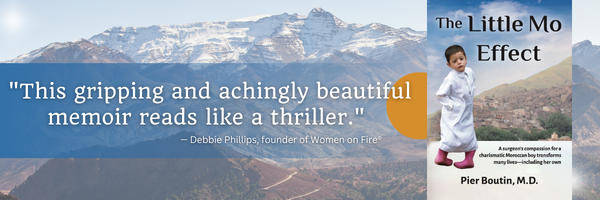Most of our stress is fueled by our own darn minds. While that may be hard to accept, it’s also the reason why yoga is the perfect antidote to stress. Our stress response is uniquely effective at helping us survive when our lives are threatened but today, this mechanism is triggered non-stop by worry and drama about money, jobs, relationships, etc. Being trapped in a constant state of stress is the new normal, but our bodies are not designed to carry this endless burden.
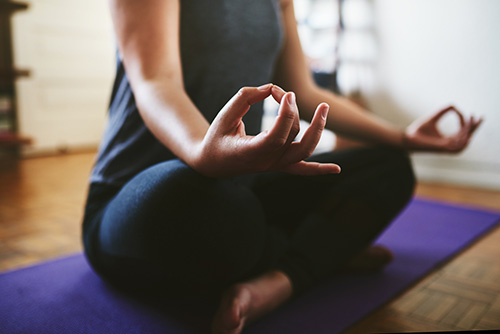
Chronic stress can damage our health, leading to stroke, heart attack, diabetes, obesity — even kidney disease. But stress also drains our adrenal reserves and triggers the adrenals to produce high amounts of the hormones adrenaline and cortisol until the glands themselves are depleted.
Being in a state of hypervigilance denies the parasympathetic nervous system (rest-and-digest) its role in turning off stress mode and bringing us back into a state of balance.
We need this balance.
But first, we need to slow down. And take deep breaths so we can replenish and restore — and prevent stress from drawing us further out of balance, pushing us from symptoms into disease.
Yoga brings balance
Our flight-or-fight response is essential for the sudden surge of energy that allows you to jump back quickly to avoid an oncoming car without even thinking about it.
But then we are supposed to go back to a calm state. These days, being stressed is more about getting caught up in mental looping, worrying about something that hasn’t even happened yet or replaying past events that made us anxious. Sound familiar?
Luckily, yoga provides the tools to help make our minds our allies so we can care for our bodies and become empowered in our own healing.
Yoga reduces stress by helping to lower high cortisol levels, balance blood sugar and reduce blood pressure. The postures bring resilience to the nervous system by calming, restoring and refreshing it.
Focused breath-work makes it harder for the mind to get caught up in a vicious circle of worries. We become calm when the breath is smooth, slow and lengthened. Meditation brings forward compassion, connectedness, presence and perspective. This clarity and awareness allow us to gently step away from the mental stress loop before it pulls us in.
This restorative yoga routine reduces stress
Restorative yoga lets you slow down, turn off the active (sympathetic) nervous system, and replenish your entire being. These postures bring the mind and body together into a state of balance and calmness by boosting the parasympathetic nervous system.
Don’t push yourself into any pose — instead use cushions or rolled blankets for support when necessary, and allow your body to open gently for the duration of each pose.
Child’s Pose (Balasana)
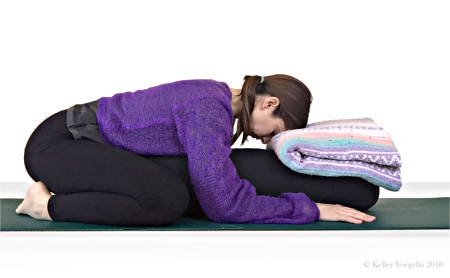
Sit on your shins with the big toes touching and pointing behind you. Place a bolster or long pillow vertically in front of you and straddle it, with knees on either side. Lie forward and hug the bolster or use your crossed arms to support your head. Rest the forehead neutrally or turn to one cheek and then the other. Stay here for a few minutes or as long as feels comfortable. Be present with your breath.
Effects: Invites calm and quiets the mind and nervous system by lowering blood pressure, releasing mental tension and relieving fatigue. This posture naturally turns your awareness inward as the brain rests forward, and brings feelings of safety, support and peace.
Reclining Bound Angle (Supta Baddha Konasana)
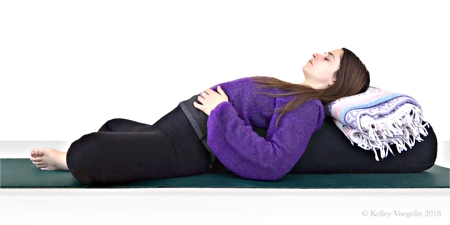
Sit on the floor with the soles of your feet touching and knees fanned out to the sides. Place a bolster a few inches behind your sacrum and lie back on it. Use a folded blanket to support the base of the head and blocks or blankets under the outer knees to help ease your hips open. Rest your arms beside you or place the palms on your belly. Stay for as long as you like. Breathe sweetly and deeply.
Effects: Promotes deeper breathing; eases anxiety, depression, headaches, fatigue and stress; nourishes the kidneys and supports the adrenals. Caring for these organs is essential for repairing the harmful effects of stress.
Legs-Up-the-Wall (Viparita Karani)
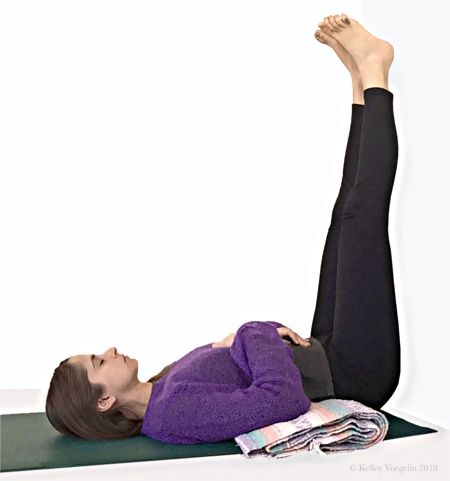
Sit next a wall and lie back, sliding your legs up the wall. You may have to wiggle forward or backward to get your legs to a comfortable angle. A blanket can be placed under the low back to create a subtle arch, or under the base of the skull for support. Extend your arms alongside you, bend the elbows like a cactus, or rest the hands on the body. Stay for 5-10 minutes and breathe gently.
Effects: One of the most deeply nourishing and restorative postures; drains away stress, anxiety or fatigue almost immediately. Being in this shape stimulates the baroreceptor reflex, which turns on the rest-and-digest nervous system, and allows a feeling of serenity, calm and quietude.
Corpse Pose (Savasana)
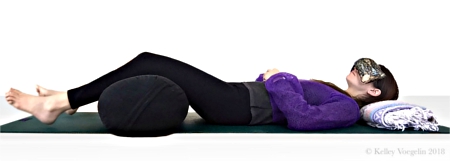
Lie on your back. Place a bolster under the bend of your knees so that the legs elevate. Release the arms beside your body, palms face up. Allow all limbs to fall evenly from the midline of your body. Stay warm under a blanket as body temperature drops when you’re deeply relaxed. Feeling cold can trigger the fight-or-flight response. Place a blanket under the base of the skull. Stay for 5-15 minutes. Breathe normally and gently.
Effects: Obscures all distractions, promotes deep relaxation, soothes anxiety and stress, relieves fatigue, replenishes and rebalances the mind and body.
A few things to consider during your restorative practice
These concepts will support your practice and aid you in releasing stress.
Go within.
Daily, we are bombarded by stimuli such as the news, cell phones, social media, etc. — all of which provoke flashes of stress with us. Let the relentless stimuli of news, cell phones and social media soften into the background and gently turn your senses inward (Pratyahara). Block out light or visual distractions with an eye pillow, folded cloth or by placing the palms gently over your eyes for a few breath cycles. Let this moment be an intentional invitation to drop beneath the surface of all that is around you.
Exhale the stress away.
In each posture, befriend your breath since short, choppy breathing causes tension. Immediately begin taking slow, deep, full breaths. Let your belly, ribs and heart expand with each inhalation and let release and relaxation pass through you with the exhalation.
Moving toward ease.
It may be difficult to suddenly land into stillness. If you truly cannot settle, try a gentle movement practice beforehand, such as a few mindful Sun Salutations — just enough to burn off some steam but don’t push toward further overload or depletion. With self-compassion and spaciousness, ease into the restorative postures, invite deep relaxation — and let go.
Returning.
Your body will let you know when it’s time to exit each posture. Do so with care — gingerly roll to one side or gently press up. For a few moments, sit quietly and observe how your body, breath, mind and heart feel. When you‘re ready, take that mindful step back into your world.
Remember, your yoga practice is rooting for you. Call upon this simple recipe to release stress, slow down, breathe out, restore, replenish and renew.
 |
Are you experiencing anxiety every day? Dr. Mary James, ND gives you three steps to feeling less stressed and more peaceful. |









